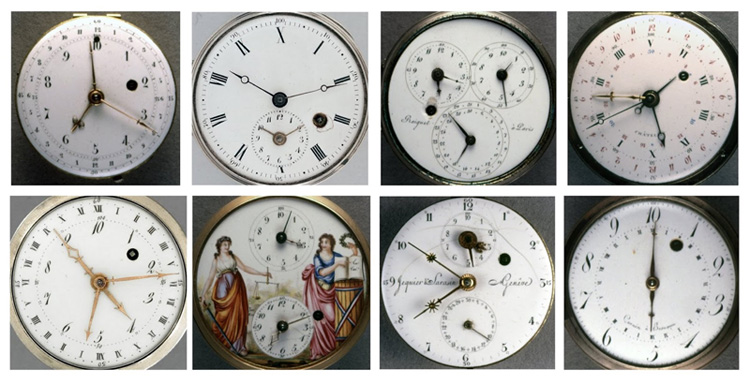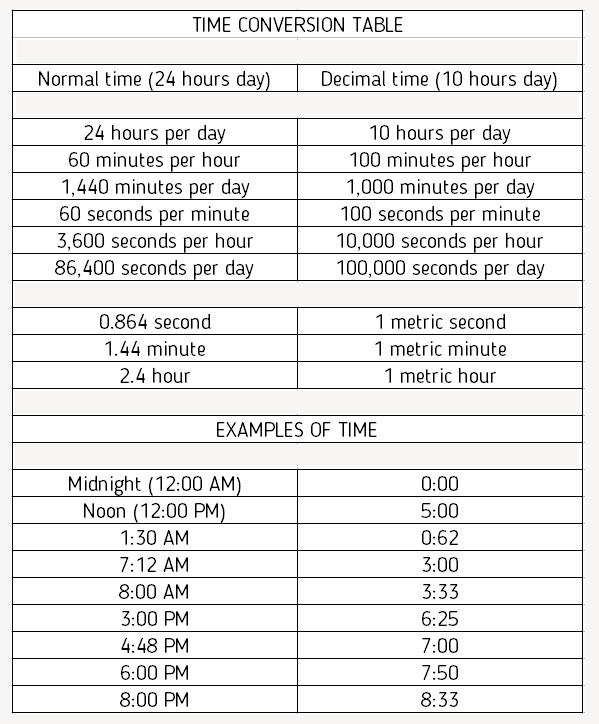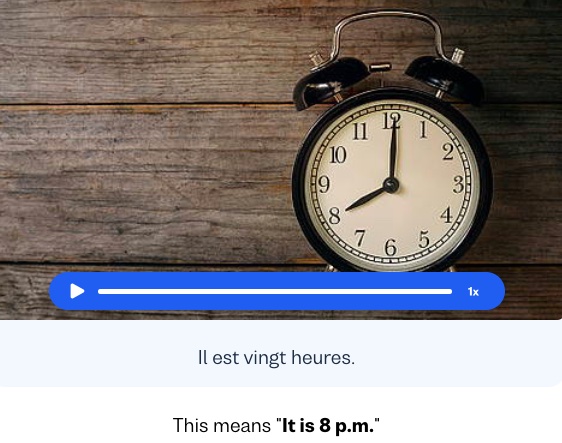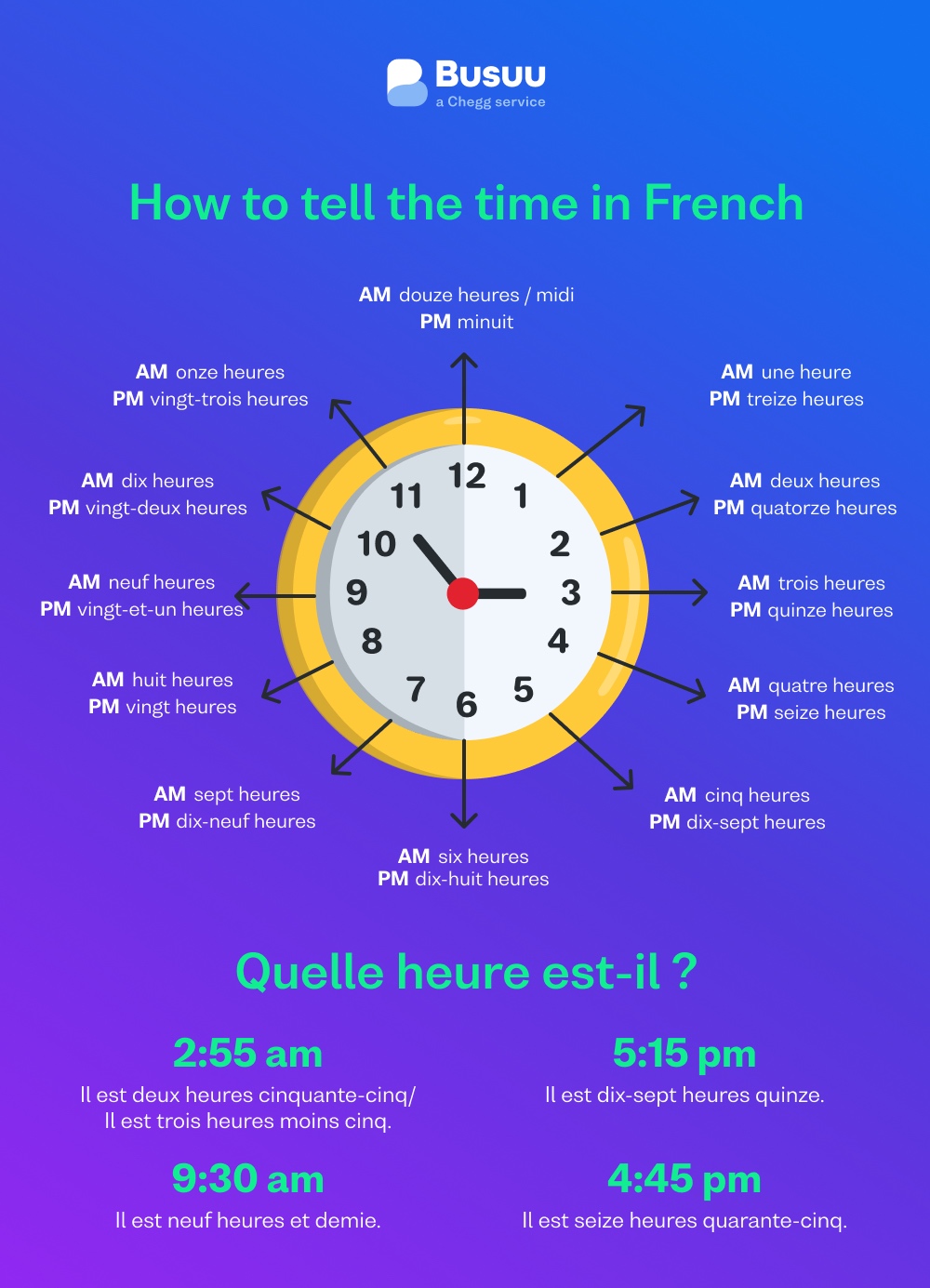|
|
General: FRENCH REVOLUTIONARY (DECIMAL) TIME 10 HOUR DAY 100 MINUTES=1 HOUR 100 SECONDS=1
Choisir un autre rubrique de messages |
|
Réponse |
Message 1 de 33 de ce thème |
|
FRENCH REVOLUTIONARY (DECIMAL) TIME
Everybody knows that there are 24 hours in a day, 60 minutes in an hour, and 60 seconds in minute. But in 1793, the French smashed the old clock system in favor of French Revolutionary Time, which was a 10-hour day, with 100 minutes per hour, and 100 seconds per minute. This thoroughly modern system had a few practical benefits, chief among them being a simplified way to do time-related math. If we want to know when a day is 80% complete, decimal time simply says "at the end of the eighth hour," whereas standard time requires us to say "at 19 hours, 12 minutes." French Revolutionary Time was a more elegant solution to that math problem. The problem was that every living person already had a well-established way of telling the time, and old habits die hard!
 French Revolutionary Time officially began on November 24, 1793 although conceptual work around the system had been going on since the 1750s. The French manufactured clocks and watches showing both decimal time and standard time on their faces (allowing for both conversion and confusion). These clock faces were spectacularly weird. French Revolutionary Time officially began on November 24, 1793 although conceptual work around the system had been going on since the 1750s. The French manufactured clocks and watches showing both decimal time and standard time on their faces (allowing for both conversion and confusion). These clock faces were spectacularly weird.

The system proved unpopular. People were unfamiliar with switching systems of time, and there were few practical reasons for non-mathematicians to change how they told time. (The same could not be said of the metric system of weights and measurements, which helped to standardize commerce; weights and measurements often differed in neighboring countries, but clocks generally did not.) Furthermore, replacing every clock and watch in the country was an expensive proposition. The French officially stopped using decimal time after just 17 months. French Revolutionary Time became non-mandatory starting on April 7, 1795. This didn't stop some areas of the country from continuing to observe decimal time, and a few decimal clocks remained in use for years afterwards, presumably leading to many missed appointments!
LIVE NORMAL AND DECIMAL TIME
Live NORMAL time
Live DECIMAL time
DECIMAL TO NORMAL / NORMAL TO DECIMAL TIME CONVERTER
Some applications using decimal time are available in both Google Play and the Apple Store. For example, for Android - DecimalTime ; for Apple - DeciTime .
LOOK/PURCHASE SVALBARD DECIMAL TIME WATCHES
IMAGES OF DECIMAL CLOCKS AND WATCHES
https://svalbard.watch/pages/about_decimal_time.html |
|
|
|
Réponse |
Message 2 de 33 de ce thème |
|
It was proposed in general in 1788 by Claude Boniface Collignon, and proposed to the National Convention in 1793 by Jean-Charles de Borda, one of the multiple prominent French technocratic military engineers of the era. It was only passed in late 1794, and then shelved in mid-1795, with well less than a year of use.
Complaints at the time included the massive cost of replacing clocks - far more costly than simple rulers and weights - especially while a war of national survival was going on. But another was the massively widespread and above all frequent use of timekeeping. Even units of distance and weight don’t come up in everyday life as often as time of day, and everyone was used to the old ways. The French Revolutionary calendar lasted longer, but eventually it was also shelved by Napoleon in 1806, and only what we know as the metric system for other quantities survived.
A few clocks were produced with decimal time, and many included the traditional system of hours too.
Overall, even when everyone knows the complexities and what may be regarded as irregular ‘flaws’, far more involved and arcane systems that are much more complicated to learn can have massive cultural inertia when getting everyone to change system would go against extremely frequent habit, even if legally unenforced (for example, English orthography!). That said, the decimal system itself is a cultural choice, probably an artefact of our ten fingers, and numbers like 60 and 24 are highly divisible (having many factors), which is helpful - so it’s not so clearly that much worse.
There was another recommendation to decimalise time in the 1897 by a commission led by Henri Poincaré (of the famous conjecture and regarded by many as the founder of modern topology, certainly algebraic topology, and cousin of the later technocratic prime minister), though it never became law, but it too was left by the wayside.
On a related note, another longer-lasting but now also essentially defunct quantity that the French Revolution decimalised was angle: the grade, later grad or gon, was 1/100 of a right angle. Scientific calculators still offered it, pretty much unused, until recently, and (as an anecdotal aside) it has a bit of a humorous status among STEM students and professors from that era. This encountered a bigger problem: although there is no very fundamental unit of time (at least none that would also be practical for ordinary use, so the tiny Planck time aside…) and decimalisation makes sense for convenient compatibility with our general number system, angle actually does have a ‘natural’ unit which makes many fundamental formulas particularly neat: the radian, the angle subtended by an arc the same length as the radius, or 1/2π of a full 360 degree revolution. If we want to be more scientific, then, there seems little value to the ‘middle’ role of the grad, and the existence of three systems is itself an inconvenience. Nevertheless, it was used in at least some quarters for far longer than decimal time, used less often than time but arguably a tiny bit more convenient for engineers and architects, etc. than degrees and radians.
https://www.reddit.com/r/AskHistorians/comments/qh3kju/in_1792_france_experimented_with_decimal_time/ |
|
|
|
Réponse |
Message 3 de 33 de ce thème |
|
Learn French anytime you want to!

Whether you want to start learning French “à vingt heures ” (at 8 PM) or tomorrow morning, you can learn French anytime, on your own way, and at your own pace, via Busuu’s free online courses and learning resources!
How to ask the time in French
Let’s start with the casual way of asking the time that works in most situations. You can use this mode to communicate with friends, family, or someone that you already know.
Il est quelle heure ? - What time is it? Est-ce que tu as l’heure ? - Do you know the time?
If you want to be more polite and respectful to the other person, or if you’re speaking with a stranger, then you can use these more formal phrases:
Est-ce que vous avez l’heure, s’il vous plaît ? — Do you have the time, please? Auriez-vous l’heure, s’il vous plaît ? - Would you please have the time? Quelle heure est-il, s'il vous plait? — What is the time, please?
And if you’re just casually asking a close friend for time, you can ask them
T’as l’heure ? - What’s the time?
You’ll be able to understand the time for sure if they show you on their watch, but if they read it out, you’ll need more vocab. Let's go the extra mile and learn how to tell the time.
How to tell the time in French
In French, time is based on the 24-hour clock, whereas in English, the 12-hour clock is used more frequently. The simplest and the most common way to tell the time in French is "il est" + Time (hours + minutes).
We measure time mainly with seconds, minutes, and hours:
Une heure/ les heures - hour/ hours Une minute/ les minutes - minute / minutes Une seconde/ les secondes - second / seconds
Let’s start with the hours in French (24-hour clock)
- It’s one o’clock. – Il est une heure.
- It’s two o'clock. – Il est deux heures.
- It’s three o’clock. – Il est trois heures.
- It’s four o’clock.– Il est quatre heures.
- It’s five o’clock. – Il est cinq heures.
- It’s six o’clock. – Il est six heures.
- It’s seven o’clock. – Il est sept heures.
- It’s eight o’clock. – Il est huit heures.
- It’s nine o’clock. – Il est neuf heures.
- It’s ten o’clock. – Il est dix heures.
- It’s eleven o’clock. – Il est onze heures.
- It’s twelve o’clock. – Il est douze heures/ il est midi.
Now the afternoon hours:
- It’s one o’clock. – Il est treize heures.
- It’s two o'clock. – Il est quatorze heures.
- It’s three o’clock. – Il est quinze heures.
- It’s four o’clock.– Il est seize heures.
- It’s five o’clock. – Il est dix-sept heures.
- It’s six o’clock. – Il est dix-huit heures.
- It’s seven o’clock. – Il est dix-neuf heures.
- It’s eight o’clock. – Il est vingt heures.
- It’s nine o’clock. – Il est vingt et une heures.
- It’s ten o’clock. – Il est vingt-deux heures.
- It’s eleven o’clock. – Il est vingt-trois heures.
- It’s twelve o’clock. – Il est minuit.
Now, to add the minutes (24-hour clock)
It is very easy to add in the minutes to the time, just mention the number of minutes after the hour.
For example:
- Il est 2 heures et cinquante-cinq minutes - It’s 2:55am
- Il est dix-sept heures et quinze minutes - it’s 5:15pm
- Il est neuf heures trente means it’s 9:30am

What time is it? It’s time to learn more French

Take your French learning to the next level with Busuu’s free online courses! Our bite-sized interactive lessons are designed by experts, and help you learn with feedback on your work from our global community of other online learners, all there to help you learn to speak like a local.
The time in French (12-hour clock)
When discussing time in French with the 12-hour clock, it’s similar to how you’d use the 24-hour clock, but you have to indicate clearly if you are referring to before noon or afternoon. In English, we’d use am or pm as indicators, but French uses this much less.
Here is some vocabulary that’ll help you indicate time of the day:
-
In the morning - du matin
-
In the afternoon - de l’après-midi
-
In the evening - du soir
-
Noon (12pm) - midi
-
Midnight (12pm) - minuit.
The fractions of time
There are ways to express time as fractions in French, such as saying, “It’s half past five.” Always remember to only use this with the 12-hour clock.
For 15 minutes past the hour — et quart E.g: Il est deux heures et quart – It’s a quarter past 2 (2:15pm)
For 30 minutes past the hour — et demie E.g: Il est 5 heures et demie – It’s half past five (5:30am)
For 15 minutes before the hour — moins le quart E.g: Il est une heure moins le quart – It is a quarter until 1 (12:45am)
Some bonus tips to help you learn the time in French
-
Using the 12-hour or 24-hour clock is entirely optional. However, the 24-hour clock is more straightforward and more commonly used across France and other European countries.
-
Fractions of time are only used with the 12-hour clock format.
-
Practice listening to the pronunciation of deux heures and douze heures. These are extremely similar, so you don’t want to confuse the two.
-
“Time” has different translations in French depending upon the context:
Time = hours of the day is - l’heure.
Time = duration is - le temps.
E.g: Depuis combien de temps apprenez-vous le français? — How long have you been studying French?
Time = frequency, i.e., the number of times - la fois
E.g: Combien de fois avez-vous visité la France ? — How many times have you visited France?
- To remember the date and time in French, you can set your phone language to French.
https://www.busuu.com/en/french/time |
|
|
|
|
| |
|
|
©2025 - Gabitos - Tous droits réservés | |
|
|

